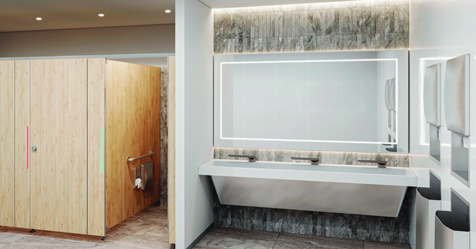If you ask 100 people whether they would prefer spending the majority of their day in a clean, fresh-smelling environment or a dirty, dingy building, chances are good that everyone would choose the former.
Each individual has his or her own notion of what “clean” is; however, most would readily agree that an environment free of dust, debris and malodors is preferable to the unkempt alternative.
Upon entering a building or a restroom, the level of cleanliness and any detectable scents are the first things a person notices.
This first opinion of a facility is a lasting one and, although the experience might be different during subsequent visits to the same building or restroom, an initial judgment has been passed — and those feelings are not easily swayed.
Can’t You Smell That Smell?
The most common culprit of foul smells is bacterial buildup.
This, coupled with the fact that a surface becomes noticeably dusty within 12 hours of being cleaned, creates a potential malodorous powder keg.
For example, if the registers in a classroom or an office building become soiled to the extent that dirt buildup is present, foul smelling matter — dust particles that have bonded with bacteria and act as a vehicle for their travel — will be distributed throughout the room every time the system pumps heated or cooled air into the area.
And, as odors and dust travel on wind currents created by heating, ventilation and air conditioning (HVAC) systems and foot traffic, it will not be long until those less-than-pleasant smells permeate other areas of the building.
A potential debacle like this can be prevented with proper odor and dust control in the form of routine cleaning.
The dusting of surfaces will control persistent or ongoing odors by eliminating them at their source while an aerosolized odor control regimen that chemically neutralizes bad smells will tackle transient or temporary odors.
Dust And Odor Annihilation
By staying ahead of the game — so to speak — and adhering to a cleaning schedule that eliminates dust and malodors at their source, the need for deep, restorative cleaning is reduced.
This allows staff time to tackle more pressing tasks — increasing productivity and contributing to higher morale.
Routinely cleaning surfaces and not allowing grime to fester means that less caustic chemicals are necessary to remove multiple layers of soil.
This results in less volatile organic compounds (VOC) being introduced into the indoor environment, reducing the chances of an adverse chemical reaction for staff or other chemical-sensitive building occupants.
By not allowing dust buildup to form or malodors to manifest, the indoor environment will be cleaner and employee and building occupant health and well-being will benefit.
A content workforce is an efficient one, and healthy building occupants are happy ones.
The Facts Don’t Lie
A recent study by the Center for Facilities Research (CFaR) at APPA co-sponsored by ISSA found that a lack of cleanliness becomes a distraction while orderly cleanliness creates good learning and working environments.
The study, entitled Cleanliness and Learning in Higher Education, was conducted by Jeffery Campbell, Ph.D., chair of the facilities management program at Brigham Young University and Alan Bigger, APPA president and former director of facilities at Earlham College.
Not surprisingly, of the 1,481 individuals polled for the study, 88 percent reported that a lack of cleanliness becomes a distraction at APPA Level 4: Moderate Dinginess.
Characteristics of Moderate Dinginess include:
- A noticeable buildup of dirt and/or floor finish in corners and along walls
- Base molding is dull and dingy with streaks or splashes
- All vertical and horizontal surfaces have conspicuous dust, dirt, marks, smudges and fingerprints
- Lamp fixtures are dirty and some are burned out
- Trash receptacles contain old trash and are stained and smell sour.
These health-hampering concerns are avoidable with sufficient odor and dust control protocols.
While the findings of the study may not relate directly to the types of facilities you clean and maintain, the data is eye opening and should conjure a desire to increase your odor and dust control efforts.
To contact the Cleaning and Maintenance Management (CMM) editorial staff, email [email protected]. You can also visit www.CMMOnline.com for more information about CMM.


